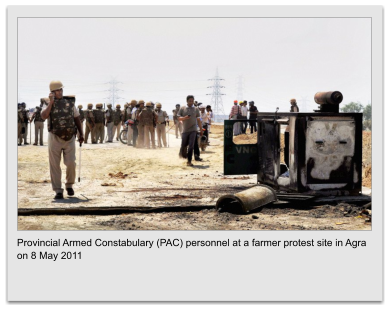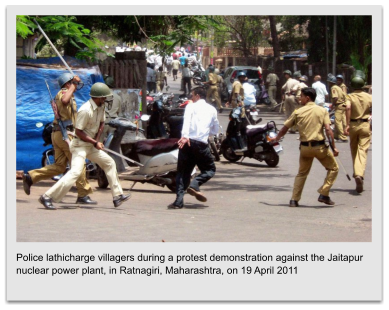

 forest rights, conservation and dilemmas of growth
forest rights, conservation and dilemmas of growth
 © mazoomdaar 2011
© mazoomdaar 2011

Or Try This for Corruption
While the great Indian middle class obsesses with cricket and corruption, an epic three-way battle is unfolding in forests
across the country. It is time to take notice, and a stand. Because, more than anything else, the outcome of this tussle will
decide India's future
Jay Mazoomdaar | 15 May, 2011 | OPEN
As the forces of tribal rights, conservation and big money lock horns
across India's forest map, who would you put your money on?
You pass? Not your fault.
For all our love of cricket, we don't fill up stands during Test matches.
Full of righteous indignation we may be, but to express itself, our
outrage needs to latch on to figures such as Rs 1,76,000 crore. Give us
a T20 encounter or a dozen-digit scam, and we will swarm any
stadium or Jantar Mantar any day.
This triangular contest does not fit the TV slots. It has been unfolding
over decades in far corners of the country. Nobody can put a figure to
what is at stake in this tussle. It is impossible to monetise the cost of
ecological damage and social unrest.
But since we love numbers, it is time to add up how many tribals and
farmers have been shot dead by the police or the forest department
over the past decade; how many cops, forest personnel and conservation activists have lost their lives; how many government and MNC
properties have been vandalised and officials injured during protests. Last weekend alone recorded four casualties: two policemen, a
farmer (Noida) and a wetland conservationist (Kolkata).
It is also time, as law-abiding citizens, to record how frequently
different authorities, from district administrations to the Prime
Minister's Office, have violated various Acts and guidelines to clear
(willy-nilly) development projects across India. Start by considering
the blatant Posco bailout in Orissa.
Since we so hate corruption, it is time to take stock of the great loot of
our natural resources, from minerals to timber, by different
government agencies in collusion with private mafia. Since we take
pride in our democracy, it is time to measure how many thousand
hectares of India's forest land is under community encroachment,
mostly cleared to the last tree. Start from Assam's Sonitpur district,
which has no control over 90 per cent of its "forests".
As the three forces collide, it is time to take stock of the massive social
and ecological churning across the country. Let us not lose sight of
ancient forest-dwelling communities, such as the Soligas in Karnataka.
As impoverished, forested districts of India continue to be hotbeds of insurgency, it is time we try to understand the desperation of the
marginalised millions, from Bengal to Maharashtra.
The only silver lining to this three-way tug-of-war is a government increasingly candid about what it wants. And don't we love
transparency? So after warning that green laws should not bring back the dreaded licence-permit raj, the Prime Minister has struck down
a proposal for an Elephant Conservation Authority that would have hampered development activity across vast landscapes.
More recently, Minister for Environment and Forests Jairam Ramesh admitted how he buckled under pressure and cleared projects that
violated green norms from time to time. But, then, Ramesh exhibits the rare skill of routinely playing martyr without ever having to
resign. He also has the unique distinction of taking every side in this three-way tussle equally eloquently.
However, even for Ramesh, walking this tightrope is getting
increasingly difficult. For the record, the now stark alignment of the
three forces began to take shape about six years ago. That was the
time when a number of mega projects, such as the Navi Mumbai
airport in Maharashtra and the Posco plant in Orissa, were proposed.
In 2005, a national tiger task force was set up to strengthen India's
conservation efforts. The next year, after a bitter tug-of-war between
rights activists and conservationists, Parliament cleared the Forest
Rights Act (FRA). It was notified in 2007 and promised millions of
forest dwellers land and other rights. Around the same time, the
Wildlife Protection Act (1972) was amended and more than 50,000
families were offered Rs 10 lakh each to vacate India's tiger reserves.
Unfortunately, barring a few exceptions, the mandate and money
meant to free the country's finest forests of human settlement is
going waste (Relocation Rumpus, May 2010) in the absence of
practical, transparent and sensitive groundwork. Implementation of
the FRA has been equally haphazard and the fate of most forest
communities still depends on the efficiency and commitment of the state government concerned.
The contention is simple. Conservationists claim that forests and
wildlife do well when protected from people. Rights activists argue that
communities are the best defenders of our wilderness when they are
offered incentives to do so. While both lobbies are busy fighting each
other's prescription to protect biodiversity, the mighty forces of power
and money are silently making inroads. In the past two years, 99 per
cent of development projects requiring forest clearance have been
okayed. Only one, Vedanta's mega plans at Niyamgiri, has been
stopped under the FRA.
Now with Posco, and a slew of other projects, cleared under duress-and
the minister being casually frank about such compromises-it is evident
which side enjoys a decisive edge in this triangular contest. Will it be a
walkover soon? Or will the tribal and conservation lobbies get real and
join hands to measure up to their mighty adversary?
Either way, if we fail to take notice when, in fact, it is time to take
sides, the great Indian middle class may well end up as collateral damage.
The author is an independent journalist.










 Home | Reports | Related Articles | Resources | Gallery | Feedback | Contact | About
Home | Reports | Related Articles | Resources | Gallery | Feedback | Contact | About

















 Home | Reports | Related Articles | Resources | Gallery | Feedback | Contact | About
Home | Reports | Related Articles | Resources | Gallery | Feedback | Contact | About














